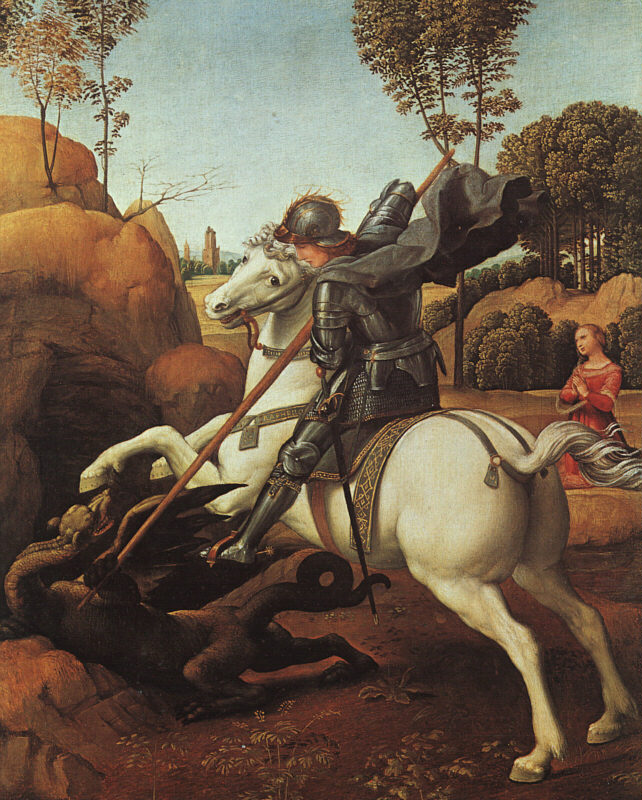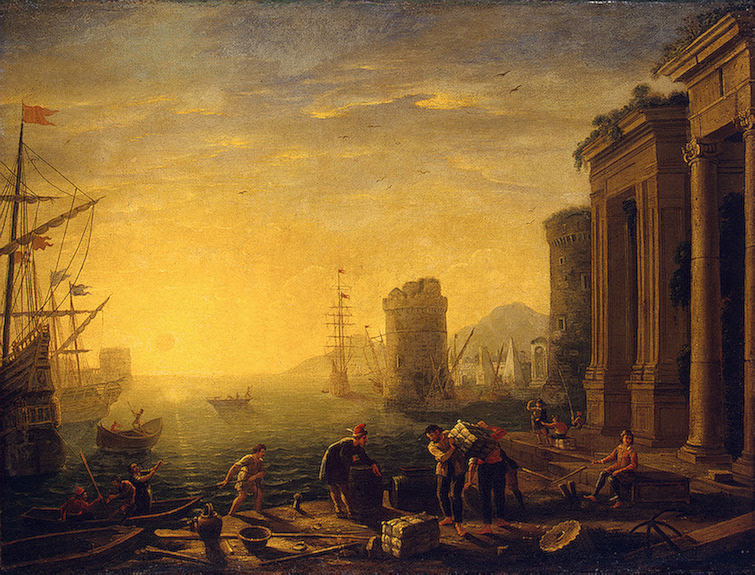
Chapter Six
"Off To London To Become a Painter -- 1799"
As the year turned into 1799, Austria, having found herself tricked, was arming once again. She was undoubtedly impressed by Great Britain's success at sea, her fleets in absolute supremacy; and Napoleon blockaded in Egypt. Lord Nelson had sailed right up to Napoleon's fleet off the mouth of the Nile and knocked the stuffing out of it just hours after Napoleon had disembarked with his troops, which we suppose were well inland when Nelson came down on the anchored French fleet. This victory at the Battle of the Nile reestablished Britain's hold on the Mediterranean and locked Bonaparte up in Egypt, thus, the timid princes of Europe were encouraged to form the "Second Coalition": England, Austria and Russia. Military action followed along right away with the Russians driving the French out of northern Italy and Nelson aiding the counter-revolutionaries in the south.
To keep armies1 and navies at war takes money, big money. And for the first time an income tax was imposed at 10%. Consumer taxes continued as they had in the past on such necessities as window glass and hay (heavy) and on other consumer goods, such as, for example: malt, coals, meat, butter, sugar, soap and candles. By 1801, we see, the bulk of government revenue was raised by taxing products, such as, tea, paper, calicoes, pepper, sugar; and on the keeping of horses (for pleasure, 10 shillings; and for work, as in agriculture, 4 s.); and on financial and legal matters, viz. Marine Insurance Policies and deeds of conveyance.2
__________________Of the four Hazlitt children3, William was the third oldest. First there was John (1767-1837), then there was Peggy. Ten years separated the brothers, a significant gap in the younger years. In 1787, as we have seen in chapter one, at the time the family located to Wem, John Hazlitt, then a young man, was left behind in London to take up his studies with Sir Joshua Reynolds. So, the last that William lived with his brother, the "artist," was when he was about nine years of age. I should think the Hazlitt family saw the oldest son, at least every Christmas, and, while I have no knowledge of it, it would not surprize me if the teenage William would be sent up to London on occasion to be with his older brother for a period of time. In 1799, William, twenty-one years of age, left home with his parents blessings to go to his brother's place to live in London. As Augustine Birrell was to point out in his work on Hazlitt: "John had many friends all of a liberal hue -- Godwins, Wollstonecrafts, Holcrafts, Rickmans, Burneys, and the like; and through these, or some of them, Hazlitt made the acquaintance of Charles Lamb, who, of all the men then living in London, was best worth knowing. The two met for the first time at the Godwins', where "a dispute was going on of a rather undergraduate complexion, a 'boshy' kind of talk, as to whether it were best to have man as he was or as he is to be."4
During the months February through to June, 1799, Hazlitt attended Lincoln's-Inn Hall to hear "a brilliant" series of Lectures on the Law of Nature and of Nations at Lincoln's Inn. The lecturer was James Mackintosh.5 Mackintosh, I will note, was "a convert not merely to the graces and gravity of Mr. Burke's style, but to the liberality of his views and the solidity of his opinions." Visionary sceptics and Utopian philosophers stood no chance with Mackintosh.
There was a greater degree of power, or of dashing and splendid effect [in the lectures]. ... Dazzling others by the brilliancy of his [Mackintosh's] acquirements, dazzled himself by the admiration they excited, he lost fear as well as prudence: dared everything, carried everything before him. The Modern Philosophy, counter scarp, outworks, citadel, and all, fell without a blow by 'the whiff and wind of his fell doctrine,' as if it had been a pack of cards. The volcano of the French Revolution was seen expiring in its own flames, like a bonfire made of straw: the principles of Reform were scattered in all directions, like chaff before the keen northern blast.
So too, at some point during the first part of the year, Hazlitt attended an exhibition of old Italian masters; he sees his first Titians, his first Raphaels, and thinks, perhaps, he could become a painter. Titian (1490c.-1576), a Venetian painter; Raphael (1483-1520), a Italian painter; and Claude Lorraine (1600-82) a French landscape painter; it was these that Hazlitt most admired and, indeed, tried to duplicate. "Till I was twenty I thought there was nothing in the world but books, when I began to paint I found there were two things, both difficult to do and worth doing; and I concluded that from that time there might be fifty."7 By October of 1799, Hazlitt is well settled in with his brother John. One of Hazlitt's biographers, P. P. Howe, imagined Hazlitt "in his brother's back painting room, or scouring the picture-galleries of the country."8
He laid about him like one inspired; nothing could withstand his envenomed tooth. Like some savage beast got into the garden of the fabled Hesperides, he made clear work of it, root and branch, with white, foaming tusks
'Laid waste the borders, and o'erthrew the bowers.'
The havoc was amazing, the desolation was complete. As to our visionary sceptics and Utopian philosophers, they stood no chance with our lecturer. He did not 'carve them as a dish fit for the Gods, but hewed them as a carcase fit for hounds.' Poor Godwin, who had come, in the bonhomie and candour of his nature, to hear what new light had broken in upon his old friend, was obliged to quit the field, and slank away after an exulting taunt thrown out at 'such fanciful, chimeras as a golden mountain or a perfect man.'6
_______________________________
Titian:

Titian's Bacchus and Ariadne, 1523-24, Museo del Prado, Madrid. (http://cgfa.sunsite.dk)
_______________________________Raphael:

Raphael's St. George and the Dragon, 1504-06, oil on wood, The National Gallery of Art at Washington D.C. (http://cgfa.sunsite.dk)
_______________________________Lorraine:

Claude Lorraine's Morning in the Harbour, Late 1630s. (www.hermitagemuseum.org)
_______________________________[Next: Chapter Seven -- The Times -- 1800-01.]
_______________________________
Found this material Helpful?
_______________________________
[TOP]
[TOC]
Notes:
1 The British, as a practical matter, sent no troops to Europe until 1808. In support of a Spanish rising, in July of that year, Arthur Wellesley (later to become known as the Duke of Wellington) led the first small British force of 9000 men into the Peninsula of Spain; a gate into the hostile fortress of Napoleonic Europe. Up to that time, since 1793, in their fight against Napoleon, the British were content to sent great sums of money to Austria and Russia so that they could put their troops in the field.
2 John Ashton's The Dawn of the XIXth Century in England (London: T. Fisher Unwin, 5th ed., 1906) p. 17 & fn at pp. 36-7.
3 Which, in 1799, would have been: John (1767-1837), age 32; Peggy, 27; William (1778-1830), 21; Harriet, 17. Incidently, John Hazlitt first made his reputation as a Miniaturist and Portrait Painter before his age 20 while in America with his family, 1783-1787.
4 See Birrell, William Hazlitt (London: MacMillan, 1902) pp. 55-6. (Herein, I refer to this work simply as Birrell.) This, of course, goes to the great dispute about the nature of man: is he driven by passion or by reason; is his nature immutable or changeable, viz. is he perfectible.
5 James Mackintosh (1765-1832) was an illustrious lawyer who eventually was knighted in 1804, the year that he went off to India to become a judge. I think it was in 1811 that he returned to England and in 1813 entered parliament as a Whig member for Nairn.
6 The Spirit of the Age, "Sir James MacKintosh."
7 As Hazlitt was to write in "Conversations of Northcote," 1830.
8 His brother John by this time had gained a reputation as "a miniature painter." From 1799 to 1804, John Hazlitt was a resident at 12 Rathbone Place.
_______________________________
Found this material Helpful?
![]()
_______________________________[UP]
[TOC -- Hazlitt's Page]
[Hazlitt's Works]
[Political Essays]
[Table-Talk:]
[The Spirit of the Age]
2011 (2019)